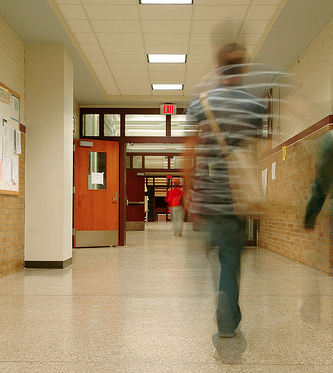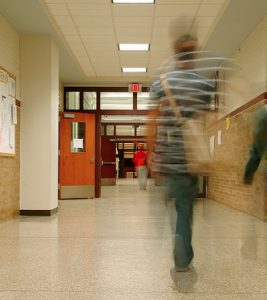Fiscal Cliff Talks: Latino Education May Slide Further

 By Curt Werner, Voxxi
By Curt Werner, Voxxi
Much was made during the presidential campaign that the economic downturn and to a large extent the nation’s tax structure combined to yield unprecedented economic disparity between haves and have-nots. While the newly re-elected president battles with recalcitrant Republicans over fundamental economic issues, a.k.a the real or imagined fiscal cliff, it might be a good idea to take a look at some of the fallout that proposed spending cuts might have on the nation’s already beleaguered public school systems.
A threat looms large that a dual economic society could lead to a state of affairs where quality education is reserved for the haves, leaving the have-nots to scramble for ways to reach an increasingly distant American dream.
 Spending cuts contained in the next federal budget could make it even more difficult for millions of families trapped in the cycle of poverty. In terms of education, Hispanic families have much to lose in their struggle to push their children ahead in a world that places higher value than ever on expertise in key areas like science, math and technology.
Spending cuts contained in the next federal budget could make it even more difficult for millions of families trapped in the cycle of poverty. In terms of education, Hispanic families have much to lose in their struggle to push their children ahead in a world that places higher value than ever on expertise in key areas like science, math and technology.
State of Hispanic education
A fast-growing U.S. Hispanic population of 50 million still sags under the weight of some of the lowest educational attainment levels, including a stubbornly high dropout rate.
Hispanics enrolled in K-12 schools number more than 12.4 million students, which means about one in five U.S. students are Hispanic. Yet almost half of all Latino students never graduate high school.
The White House addressed the matter in April of last year when it outlined a series of steps designed to improve educational achievement among Hispanics.
President Obama has made it a point to advance Hispanic education with a focus on improving pre-K and early childhood instruction. He has said and many educators agree, that achievement among Hispanic students is key if the U.S. wants to have the highest proportion of college graduates in the world, a goal the president has set to reach by 2020.
Despite an outsized margin of victory in the recent elections, the president still faces strong headwinds in his efforts to reach that goal and actually improve Hispanic education opportunities.
Fiscal cliff, vouchers and what lies ahead
Declining tax revenues since 2008 have forced cuts in a number of vital public services at the state level, among them education, where thousands of teachers have been set adrift in an unprecedented swath of layoffs that have crippled many local school systems. Untold numbers of others have been discouraged from joining the teaching profession by low pay and that same threat of cutbacks.
These layoffs might stymie gains in education but have served to delight Tea Party politicians and their ardent followers, many of whom view public education as an ideological enemy.
On the other hand, the political right has always supported school vouchers, which opponents insist would give students from well-off families yet another leg up and further drain precious resources from public schools by slashing much-needed funding for salaries, supplies and construction, much of it long overdue.
Vouchers generally favor those already able to pay for private and parochial school and it’s no longer uncommon for parents to send their preteens to private schools costing upwards of $40,000 a year. In other words, school vouchers can be exposed by and large as another Republican program of aid for the wealthy.
Voucher talk aside, Hispanic education faces persistent obstacles to achievement.
To begin with fewer than half of Latino children are enrolled in any early learning program. Only about half of all Latino students earn their high school diploma on time; those who do complete high school are only half as likely as their peers to be prepared for college. It’s no surprise then, to find that a scant 13 percent of Latinos have a bachelor’s degree, and only 4 percent have completed graduate or professional degree programs.
The Head Start and Early Head Start programs promote school readiness by enhancing the cognitive and social development of children through the provision of education, health, nutritional, social, and other services to enrolled children and families.
At the requested funding level, more than 968,000 children—more than 854,000 in Head Start and 114,000 in Early Head Start—can participate in the program, up from 904,000 in 2009. Thirty-six percent of the Nation’s Head Start children are Latino, the largest of any minority group in the U.S.
Overall, Latinos have the lowest education attainment level of any group in the U.S. Aside from immigration reform on the federal level, the matter of Hispanic education is a challenge that looms even larger.
The President’s 2012 budget request would increase funding for Head Start and Early Head Start by $866 million for a total of $8.1 billion. Reducing funding for proven programs like Head Start and overall fiscal support for public schools, whether indirectly through vouchers or more directly by outright cuts in education funding, would amount to a setback the nation as a whole can ill afford.
This article was first published in Voxxi.
Curt Werner has covered both the business and clinical sides of healthcare for more than 25 years mostly for trade publications. He has written on cardiology, orthopedics, seniors and supply chain issues for hospitals and other healthcare entities.
[Photo By SCA Svenska Cellulosa Aktiebolaget]
